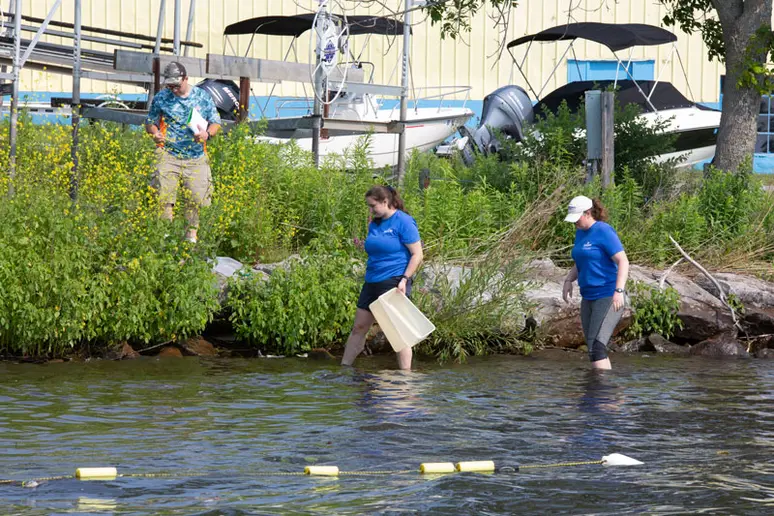

Dr. Courtney Wigdahl-Perry (right) joins Kasey Crandall and Madison Miller in collecting water samples in Chautauqua Lake in the summer of 2021.


Dr. Courtney Wigdahl-Perry (right) joins Kasey Crandall and Madison Miller in collecting water samples in Chautauqua Lake in the summer of 2021.
Researchers are gaining a better understanding of factors that can influence the growth of harmful algae blooms in Chautauqua Lake, thanks to research compiled last summer by two undergraduate science students at SUNY Fredonia.
Kasey Crandall of Stockton, who graduated in May with a B.S. in Interdisciplinary Studies – Environmental Sciences and a minor in Biology, and Madison Miller, of Forestville, who will be a senior this fall with majors in Biology and Environmental Science and a minor in Chemistry, conducted tandem water analyses of previously unknown aspects of the lake, under the supervision of Department of Biology Associate Professor Courtney Wigdahl-Perry in 2021.
“We learned a lot from Madison’s research, that iron does not seem to stimulate algae growth. We did not really expect it to elicit a large response, if any, but no one had ever tested it before,” Dr. Wigdahl-Perry said.
“This experiment allowed us to test that clearly to see if it is an important consideration in Chautauqua Lake. Cyanobacteria (the group responsible for harmful algae blooms) have a high iron requirement (more so than other groups of algae) -- so if there isn't enough iron in the system, their growth can be restricted,” Wigdahl-Perry explained.
“We are investigating multiple causes of blooms, so it helps to confirm that iron is not a major player. Additionally, there are other interesting water chemistry interactions between iron and other nutrients that make it important to understand,” Wigdahl-Perry noted.
These findings are helpful to know when looking at the bigger picture of nutrients in the system, Wigdahl-Perry said. “That question came up from other academic partners, so we will be sharing the data with fellow researchers at the lake,” she added.
Water samples for Ms. Miller’s research, “Monitoring of Harmful Algal Blooms and Nutrient Availability in Chautauqua Lake,” were collected in the lake’s north and south basins. A somewhat counterintuitive finding suggested that the volume of algae decreased slightly with iron additions, which may be due to changes in the species of algae present. Samples are still being examined to understand why this happened, Wigdahl-Perry noted.
Mr. Crandall’s research, “Thermal Stability and Harmful Algae Bloom Surveillance at Chautauqua Lake,” examined how water moves or flows throughout the lake by tracking the temperature of water and mixing patterns in the lake. Six different sensor lines measuring temperatures at different levels were placed in the south basin. Individual sensors were placed, beginning at the lake bottom, at increments of 1-1/2 meters.
“What we see at the lake surface doesn’t tell the whole story of the lake itself. In some lakes, we have layers based on temperature, and in some, the warmer surface layer stays separate from a deep, cooler layer,” Wigdahl-Perry explained. As a result, the chemistry and overall environment at the surface is different from the bottom layer.
A long-held assumption that the shallower south basin does not have different layers, or stratification, was debunked.
“Kasey found short periods of stratification, that had never been documented before, which is really interesting, since the south basin maxes out at a little over 6 meters in depth, or 18 feet,” Wigdahl-Perry said. Temperature variations and oxygen levels impact nutrient concentrations, she explained, which in turn affect aquatic life in the lake.
Crandall’s research also found that water temperature is greatly influenced by wind. “We saw some really interesting basin-wide patterns that we didn’t expect to see, and are still analyzing them,” Wigdahl-Perry said. Water temperature appears to be connected to wind speed and direction.
Both students gave a combined poster presentation of their Chautauqua Lake research at the virtual Northeast Global Lake Ecological Observatory Network (GLEON) Conference, which was co-chaired by Wigdahl-Perry and held in April. Their poster was also presented at SUNY Fredonia’s OSCAR Expo in May.
Miller is continuing research this summer through the National Science Foundation’s Research Experiences for Undergraduates (REU) at the University of Toledo (Ohio). Harmful algal blooms are among topics to be addressed by students in this REU program.
Crandall will pursue a M.S. degree in Biology at SUNY Fredonia in this fall.